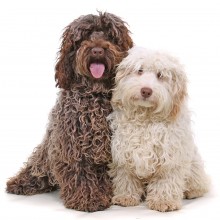Cockapoo
Lifestyle Needs

The name ‘Cockapoo’ is given to a cross between a Poodle and Cocker Spaniel (so is not a breed in the accepted sense). This may be an English or American Cocker Spaniel, or working Cocker Spaniel, with a Miniature Poodle. The appearance and size of a Cockapoo will depend on which two breeds are used. The offspring of such a mating is known as an F1 cross and may have the added benefit of heterosis (or ‘hybrid vigor’. If two Cockapoos are mated together, this is known as F2. An F2 bred to an F2 will result in an F3, and so on. If an F1 is bred back to either parent breed it is an F1B. More details may be found here: www.cockapooclubgb.co.uk Temperament will vary but typically, if well socialised as puppies, the Cockapoo will be a lively, good natured family pet. There is the potential for owners to less likely to be allergic to these dogs, but zero or low allergy is not guaranteed even within the same litter.
Genetic Diversity
(Known as Coefficient of Inbreeding: 'COI'. It should be as low as possible.)
An F1 Cockapoo’s COI will be 0%
F1B (an F1 bred back to either breed) should be no higher that 6.25% (ensuring no common ancestry within great grandparents, or third generation)
F2, F3, F4 should be no higher that 6.25% (using CCGB Club registration papers showing no common ancestry on 3 generation lineage record)
See 'A Beginners Guide to COI'
Gene Pool Size
(Known as Effective Population Size: 'EPS')
TBC
EPS is a measure of how many individuals are contributing genetically to a breed population. It is a measure of the size of the gene pool in a breed. Lower than 100 is considered critical by conservationists and below 50 brings a breed close to extinction. For more information see the Kennel Club article.
Health and Welfare Problems due to Conformation
(Body shape and physical characteristics)
- The Cockapoo’s coat can become tangled and matted if left ungroomed, so should be tended to on a regular basis.
BVA/KC Health Schemes: www.bva.co.uk/chs
- Hip dysplasia (HD)
- Elbow dysplasia (ED)
- Eye disease
Estimated Breeding Values (EBVs) : No EBVs are currently available for this breed
www.thekennelclub.org.uk/about-ebvs
DNA Tests Available
DogWellNet and IPFD Harmonisation of Genetic Testing for Dogs (HGTD)
www.dogwellnet.com/breeds
- See relevant parent breeds
Availability of a DNA test does not mean that it is always necessary or even desirable for breeders to use this test.
Other Breed-Specific Health Screening Schemes
- List of breeding requirements for club members:
www.cockapooclubgb.co.uk/health-testing.html
Ask the breeder to show you the certificates for the above tests/screening for both parents. If any of the above tests have not been considered necessary by the breeder (and there may be good reasons), ask her to explain why.
Other Diseases Reported
(For which there are currently no genetic or screening tests for sire or dam)
- Patellar luxation (dislocated kneecap causes osteoarthritis and chronic pain)
- Cancer: basal cell tumors
- Check Other diseases in the relevant parent breeds
Ask the breeder about the medical history of the parents, grandparents and great grandparents. Consider carefully whether to purchase a puppy if some of these or other diseases are in the family line.
Ask about the breeder’s policy in cases of serious genetic diseases occurring to your puppy in later life. Good breeders will request to be informed of such events in order to improve future breeding decisions.
You are strongly advised to buy from a breeder who uses (or is prepared to use) the AWF Puppy Contract and Puppy Information Pack (PIP): www.puppycontract.org.uk
The breeder should also be familiar with the CFSG/DBRG Code of Practice for Dog Breeding